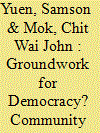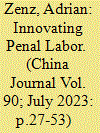|
|
|
Sort Order |
|
|
|
Items / Page
|
|
|
|
|
|
|
| Srl | Item |
| 1 |
ID:
192602


|
|
|
|
|
| Summary/Abstract |
Professional and liberal-oriented news media in Hong Kong have been under severe political pressure since the establishment of the National Security Law in 2020. Journalists now have to navigate a more dense and uncertain legal minefield. Self-censorship has intensified. This article argues that self-censorship and other media responses can be better understood under the broader framework of risk culture. Drawing upon 43 in-depth interviews with journalists from 12 organizations, this article reconstructs how news organizations and journalists have developed methods to assess and manage risk and describes the characteristics of their risk assessment and management and the changing character of self-censorship. The emerging risk cultures have helped maintain organizational stability and journalistic professional identity. The concluding discussion elaborates on the implications of the analysis for understanding self-censorship and press freedom in Hong Kong, briefly compares Hong Kong’s situation with mainland China’s, and reflects on the possible development of risk cultures in other institutional contexts.
|
|
|
|
|
|
|
|
|
|
|
|
|
|
|
|
| 2 |
ID:
192597


|
|
|
|
|
| Summary/Abstract |
With modest income differences and virtually no private wealth four decades ago, China’s inequalities of income and wealth are now almost as extreme as in the United States and Russia. Despite unusually high levels of state control over national assets and strong fiscal capacity, redistribution of income and wealth is barely measurable. This puzzling outcome is a by-product of China’s highly distinctive political and economic structures, which retain many features of the prior state socialist model. These structures are designed to maintain Communist Party control, enforce the priorities of the central Party-state, and push rapid growth through high levels of investment. They include migration controls coupled with state ownership of land, an enduringly large capital-intensive state sector served by a financial system dominated by state banks, a tax base heavily dependent on the scale of production, a fiscal system that favors central priorities and drives subnational governments into land expropriation and property development, and the near absence of taxes on household property and related income.
|
|
|
|
|
|
|
|
|
|
|
|
|
|
|
|
| 3 |
ID:
192600


|
|
|
|
|
| Summary/Abstract |
Studies on Hong Kong’s contentious politics have focused primarily on the high tides of mobilization. Scant attention is paid to what became of the intense mobilizations following their decline. This article spotlights the “abeyance” politics of community activism, in which activists sought to make territorial communities an arena of social and political participation in quieter times after mass mobilizations. Drawing on the concept of abeyance from political sociology, we argue that community activism served as “abeyance structures” after the mass mobilizations in the early 2010s, a major protest cycle preceding the 2019 anti-extradition movement. Based on mixed methods and original data, we argue that these abeyance structures not only allowed activists to maintain their political engagement but also gave rise to various practices of “lived citizenship” in territorial communities. These practices produced a changing sense of political subjectivity among citizens, establishing a more grounded notion of democracy that emphasizes their participation in local affairs and social entitlements. Our findings aim to enrich the literature on movement abeyance and provide a nuanced understanding of political activism in Hong Kong beyond street politics.
|
|
|
|
|
|
|
|
|
|
|
|
|
|
|
|
| 4 |
ID:
192598


|
|
|
|
|
| Summary/Abstract |
This article argues that China’s campaign of reeducation and forced labor in the Xinjiang Uyghur Autonomous Region through so-called Vocational Skills Education and Training Centers (VSETCs) represents a significant conceptual innovation over prior labor reform. Beijing’s erstwhile penal labor systems treated labor as an integral part of reeducation but suffered from limited reeducation results, low work productivity, and poor resocialization outcomes. In contrast, the VSETC system pragmatically eschews Maoist tenets of labor’s transformational power: its internment camps prioritize intensive reeducation, followed by a process of gradual release into potentially more efficient nonprison enterprises. The resulting potential profitability gains translate into higher economic sustainability—an essential prerequisite for the system’s primary goal of long-term assimilation and coercive integration of resistant ethnic groups into Beijing’s social order. However, VSETC’s and the region’s focus on control and disintegrating ethnic social capital undermines its integrative efforts, replicating a long-standing weakness of prior labor reform.
|
|
|
|
|
|
|
|
|
|
|
|
|
|
|
|
| 5 |
ID:
192599


|
|
|
|
|
| Summary/Abstract |
China’s rapid urbanization has generated a substantial population of “landless peasants,” villagers whose farmland has been fully expropriated. The fate of these “landless peasants” has varied greatly from locale to locale. In many cities, they have become wealthy urban landlords; in others, they have been pushed aside in the urbanization process. When they have become urban landlords, they have often done so through the formation of village collective shareholding corporations and villages-in-the-city (chengzhongcun 城中村, also known as “urban villages”), which have in turn provided housing for many migrant workers. Through a comparison of Guangzhou, with its many villages-in-the-city and powerful village collectives, and Shanghai, with far fewer villages-in-the-city or village collectives, this article argues that these starkly divergent physical, institutional, and distributive outcomes have been the result of divergent municipal policies that seek to urbanize peasants in very different ways. In both Guangzhou and Shanghai, although these urbanization policies were rooted in path dependency and local culture, they were subject to abrupt change by municipal leaders with new ideas.
|
|
|
|
|
|
|
|
|
|
|
|
|
|
|
|
| 6 |
ID:
192601


|
|
|
|
|
| Summary/Abstract |
During the Anti-extradition Movement in Hong Kong, a wave of new unions surfaced—18 newly registered unions in 2019 and 491 in the first half of 2020. This article examines and analyzes the factors behind this upsurge in new union activism and asks how protesters acquired trade union consciousness. Previously, in the throes of an earlier protest movement in 2014 led by young people who valued individualism, self-activism, spontaneity, and post-materialism, hierarchically structured institutions were distrusted and scorned, including trade unions. Yet half a decade later, during the 2019–20 protest movement, many thousands of participants joined forces to form the new unions. These took the shape of a new type of union known in labor studies as “social movement unionism.” Despite having little experience, the new unions were able to sustain themselves, and some began to engage not only with political activism but also with management-labor issues and worker rights. This article draws on extensive interviewing during 2020–22 with labor activists and trade union organizers from old and new unions.
|
|
|
|
|
|
|
|
|
|
|
|
|
|
|
|
|
|
|
|
|